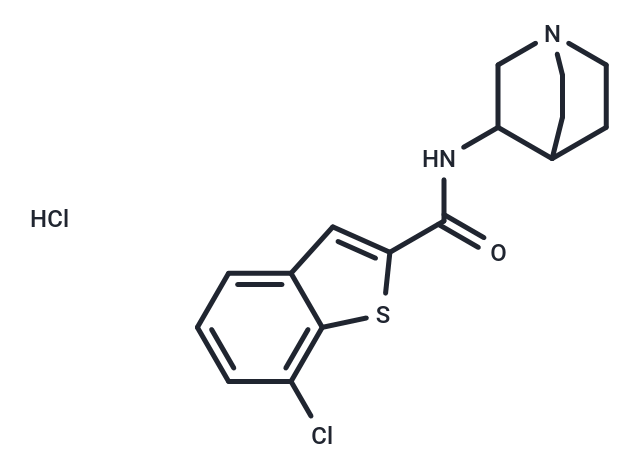Shopping Cart
Remove All Your shopping cart is currently empty
Your shopping cart is currently empty
Encenicline hydrochloride (EVP-6124 hydrochloride) is a novel partial agonist of α7 neuronal nicotinic acetylcholine receptors (nAChRs).

| Pack Size | Price | USA Warehouse | Global Warehouse | Quantity |
|---|---|---|---|---|
| 1 mg | $54 | In Stock | In Stock | |
| 5 mg | $127 | In Stock | In Stock | |
| 10 mg | $198 | In Stock | In Stock | |
| 25 mg | $413 | In Stock | In Stock | |
| 50 mg | $662 | In Stock | In Stock | |
| 100 mg | $1,050 | - | In Stock | |
| 1 mL x 10 mM (in DMSO) | $138 | In Stock | In Stock |
| Description | Encenicline hydrochloride (EVP-6124 hydrochloride) is a novel partial agonist of α7 neuronal nicotinic acetylcholine receptors (nAChRs). |
| In vitro | EVP-6124 hydrochloride displaces [3H]-MLA (Methyllycaconitine) (Ki=9.98 nM, pIC50=7.65±0.06, n=3) and [125I]-α-bungarotoxin (Ki=4.33 nM, pIC50=8.07±0.04, n=3). EVP-6124 is approximately 300 fold more potent than the natural agonist ACh (Ki=3 μM), measured in binding assays using [3H]-MLA. EVP-6124 inhibits the 5-HT3 receptor by 51% at 10 nM, the lowest concentration tested. Evaluation of the human 5-HT2B receptor expressed in CHO cells demonstrates displacement of [3H]-mesulergine (Ki=14 nM) and only antagonist activity in the rat gastric fundus assay at an IC50 of 16 μM. In binding and functional experiments, EVP-6124 shows selectivity for α7 nAChRs and does not activate or inhibit heteromeric α4β2 nAChRs[1]. |
| In vivo | EVP-6124 hydrochloride demonstrates effective brain penetration and sufficient exposure duration, showing significant memory restoration at a dose of 0.3 mg/kg orally in scopolamine-induced memory impairment in rats, measured by an object recognition task (ORT). When combined with donepezil at sub-efficacious doses (0.1 mg/kg, orally for donepezil and 0.03 mg/kg, orally for EVP-6124), full memory restoration is achieved, suggesting synergistic effects. In a 24-hour retention natural forgetting test, EVP-6124 at 0.3 mg/kg orally enhances memory, an effect inhibited by the selective α7 nAChR antagonist methyllycaconitine, validating the involvement of α7 nAChR in the mechanism of action. EVP-6124 binds to rat plasma proteins at a moderate level with a fractional unbound average of 11% and shows dose-proportional pharmacokinetics over a 0.1-30 mg/kg oral dose range. Peak times (Tmax) are recorded at 4 hours in plasma and 2 hours in the brain, with brain concentrations maintaining from 2 to 8 hours, and brain-to-plasma (B:P) ratios ranging from 1.7 to 5.1. Additionally, at a dose of 0.4 mg/kg intraperitoneally, EVP-6124 achieves peak brain concentration in 2 hours, maintaining effective levels for at least 4 hours, and notably increases NMDAR saturation index in wild-type mice without affecting wakefulness or locomotion. |
| Kinase Assay | Binding or activity of EVP-6124 is measured at 10 μM in a selectivity panel according to standard validated protocols under conditions defined by the contractor. For the 5-HT2A receptor binding assay, membranes are prepared from HEK293 cellsexpressing the human recombinant 5-HT2A receptor. For 5-HT2B and 5-HT2C receptor binding assays, membranes are prepared from CHO cells expressing the human recombinant 5-HT2B or 5-HT2C receptor. Affinity is determined by incubating different concentrations of EVP-6124 in binding buffer for 1 h. For 5-HT2A binding, the incubation is at 22°C in the presence of 0.5 nM [3H]-ketanserin; for 5-HT2B, at 22°C in the presence of 2 nM [3H]-mesulergine; and for 5-HT2C, at 37°C in the presence of 1 nM [3H]-mesulergine. Nonspecific binding is determined in the presence of 1 μM ketanserin, 10 μM mesulergine, or 10 μM RS-102221 for 5-HT2A, 5-HT2B, or 5-HT2C, respectively. All measurements are performed in triplicate. EVP-6124 is also tested in the 5-HT2B rat gastric fundus tissue response assay. Briefly, inhibition of α-methyl serotonin-induced contraction is isometrically measured. All measurements are performed in duplicate[1]. |
| Synonyms | EVP-6124 hydrochloride, EVP-6124 (hydrochloride) |
| Molecular Weight | 357.3 |
| Formula | C16H17ClN2OS·HCl |
| Cas No. | 550999-74-1 |
| Smiles | Cl.Clc1cccc2cc(sc12)C(=O)NC1CN2CCC1CC2 |
| Relative Density. | no data available |
| Storage | Powder: -20°C for 3 years | In solvent: -80°C for 1 year | Shipping with blue ice/Shipping at ambient temperature. | |||||||||||||||||||||||||
| Solubility Information | DMSO: 10 mg/mL (27.99 mM), Sonication is recommended. | |||||||||||||||||||||||||
| In Vivo Formulation | 10% DMSO+40% PEG300+5% Tween 80+45% Saline: 1 mg/mL (2.8 mM), Sonication is recommended. Please add the solvents sequentially, clarifying the solution as much as possible before adding the next one. Dissolve by heating and/or sonication if necessary. Working solution is recommended to be prepared and used immediately. The formulation provided above is for reference purposes only. In vivo formulations may vary and should be modified based on specific experimental conditions. | |||||||||||||||||||||||||
Solution Preparation Table | ||||||||||||||||||||||||||
DMSO
| ||||||||||||||||||||||||||
| Size | Quantity | Unit Price | Amount | Operation |
|---|

Copyright © 2015-2025 TargetMol Chemicals Inc. All Rights Reserved.